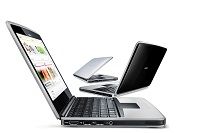Performance
There is no doubt that the Booklet 3G is impressive to look at, as well as highly portable. However, its performance lags behind.
Despite Nokia's insistence that this is a mini laptop, the computing specification is largely that of a standard netbook: a 1.6Ghz Intel Atom processor, 1GB of memory, integrated graphics and a 120GB hard disk. The technical specification really fails to do justice to the industrial design, and even running Microsoft's relatively snappy Windows 7 Starter, which booted quickly, the Booklet was challenged to do much beyond basic tasks in Office.
Our review sample was a pre-production model but none the less results were disappointing. The Booklet's video seems to be its weakest point: it struggled to play back YouTube, and other video sources, over an 802.11n Wi-Fi connection. Even some graphics-heavy websites failed to load quickly enough. As a result, it hardly seemed fair to try outputting HD video over the HDMI connection.
Running over 3G, the Booklet was also prone to dropped connections, in particular in areas with a poor signal. In good coverage areas, the connection was as quick as can be expected from an HSDPA data connection.
For some reason, the connection software built in to Windows 7 failed to recognise a Vodafone 3G SIM properly, although it worked out of the box with Orange. Inputting the Vodafone cellular access point settings manually fixed the problem. But it does seem that Nokia have missed an opportunity to put a smartphone-style connection management application on the Booklet, rather than relying on Windows 7 alone.
The software Nokia does provide the Ovi suite is great for synchronising contacts or media content with a Nokia handset, but not in itself a reason to buy a Booklet. The most useful business feature is likely to be Ovi Maps, which makes use of the Booklet's A-GPS sensor. Note, though, that GPS won't work indoors, and the GPS data is not available to other applications on the Booklet unless users upgrade Windows 7.
The Booklet does have one standout feature, though: its battery life. Nokia claims up to 12 hours between charges. We couldn't quite manage that but did achieve over eight and a half hours from a single charge, running Office and mixing Wi-Fi and 3G connections.
The battery life and the design are almost enough to convince us to overlook the Booklet's other shortcomings. But 100 off the price would be more convincing still.
Verdict
There’s no doubt that the Nokia Booklet 3G is attractive and well built. However, its feature set puts it at the low end of the netbook market, yet it carries a high-end price tag.
Built-in 3G connectivity and a battery that genuinely will last for a working day set it out from the crowd, but in return Nokia is asking for a price premium that would make even Apple blush. To work as a business device, the Booklet 3G needs to be faster, cheaper or - ideally - both.
Processor: 1.6GHz Z530
Memory: RAM: 1GB DDR2
Storage: 120GB
Graphics: Intel Poulsbo US15W (which includes Intel GMA 500 graphics)
Display: 10.1in (1280x720 pixels)
Ports: 3 x USB, HDMI, SD card reader, SIM, 3.5mm headphone jack
Connectivity: 802.11b/g/n, 3G webcam, A-GPS
OS: Windows 7 Starter
Dimensions: 264x185x19.9 mm
Battery: 56.8 Wh
Weight: 1.25kg














